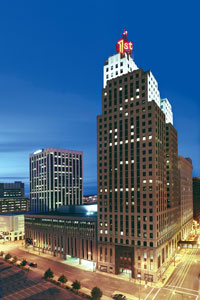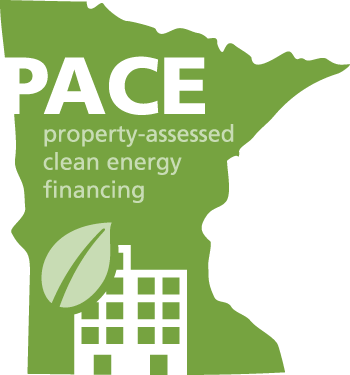The 417-foot, 32-story First National Bank Building in downtown Saint Paul was constructed in 1931 and competed with New York City’s Empire State Building for construction materials. Madison Equities, the new owner of the building as of winter 2015, worked with Petros PACE Finance and the Saint Paul Port Authority to make $6.8 million in energy efficiency upgrades ($5M from Petros and $1.8M from SPPA), including energy management, HVAC, LED lighting, and occupancy sensors. These improvements are expected to reduce energy consumption and related costs by 35-40%.
Property-Assessed Clean Energy (PACE) is a new way to finance energy efficiency and renewable energy upgrades to the buildings of commercial property owners. Energy-saving measures pursued by the owners receive project financing and are repaid as a separate item on their property tax assessment for a set period. PACE eliminates the burden of upfront costs by providing low-cost, long-term financing. In the case of the First National Bank building the assessment is placed and managed by Ramsey County.
“PACE will allow Madison Equities to pass the costs (PACE assessment payments) on to the tenants that are going to see the reduction in energy costs,” noted Peter Klein who runs Saint Paul Port Authority’s PACE program. “Otherwise, this would be a big negative cash outflow to the building owner, making it unlikely that they would go ahead with the project. That is why PACE is such a good solution for multi-tenant buildings. It is also positive cash flow to the tenants since the energy savings will be greater than the PACE assessment payments.”
We talked to Chris Droske, an Energy Advisor with Franklin Energy Services, to learn more about the building and it’s energy-efficient transformation.
The First National Bank in downtown Saint Paul is an iconic building (and sign!). What were some of the highlights about working on this project?
 Chris Droske: The First National Bank building is one that nearly every motorist sees as they pass through downtown Saint Paul on any given night due to the large flashing “1st” sign atop the building. Some of my favorite parts of the energy auditing and project implementation process was finding ways to optimize the facility’s energy performance while maintaining its historic and iconic appearance. One of the first projects that was an area of focus was converting the rooftop sign from neon to LED. While saving energy and reducing maintenance costs were large priorities to Madison Equities, maintaining the appearance of the sign was equally important and we had to work together to find vendors that could replicate the neon look with the new LED technology.
Chris Droske: The First National Bank building is one that nearly every motorist sees as they pass through downtown Saint Paul on any given night due to the large flashing “1st” sign atop the building. Some of my favorite parts of the energy auditing and project implementation process was finding ways to optimize the facility’s energy performance while maintaining its historic and iconic appearance. One of the first projects that was an area of focus was converting the rooftop sign from neon to LED. While saving energy and reducing maintenance costs were large priorities to Madison Equities, maintaining the appearance of the sign was equally important and we had to work together to find vendors that could replicate the neon look with the new LED technology.
Where were some of the greatest energy savings found?
Chris Droske: In the First National Bank, significant energy savings were found in both lighting opportunities and HVAC upgrades. Upgrading fluorescent and incandescent fixtures to LEDs was one of the first projects pursued due to the quick payback and relative ease of implementation. Much of the HVAC equipment was several decades old and Madison Equities decided that they would like to bring the building up to more modern control strategies and replace core equipment to increase reliability. The key projects here involved upgrading to a new centrifugal chiller, converting their air handling equipment from a constant volume system to a variable air volume system, and upgrading from pneumatic to direct digital controls for their automated control system. These new systems will allow them to adjust airflow and the amount of heating and cooling provided based upon building occupancy and demand.
 How was it working on a project of this magnitude?
How was it working on a project of this magnitude?
Chris Droske: This may well be the largest building I have every had the privilege of performing an energy audit at and definitely one of the most historic. Whenever you work on projects of this magnitude there are a lot of parties involved that all need to agree on the next steps to make forward progress, and on this project that is exactly what happened. Xcel Energy, Madison Equities, and several vendors worked to define and redefine the scope, find available incentives and financing, and ensure they could get projects done within the one year timeline to receive the additional 30% bonus that is offered through the Turn Key program. I think to all of us working on the project, it brings a smile to our faces knowing the environmental and monetary impact of the energy savings from projects implemented. It is exciting, knowing we are helping to preserve such a historic building in downtown Saint Paul while minimizing its overall energy usage.
Media coverage of the project:
- MPR News (in depth)
- MPR News (relighting)
- Fox 9
- Star Tribune
- Pioneer Press (in depth)
- Pioneer Press (story)
- Pioneer Press (photos)
- Business Journal
- Finance & Commerce
- Midwest Energy News



